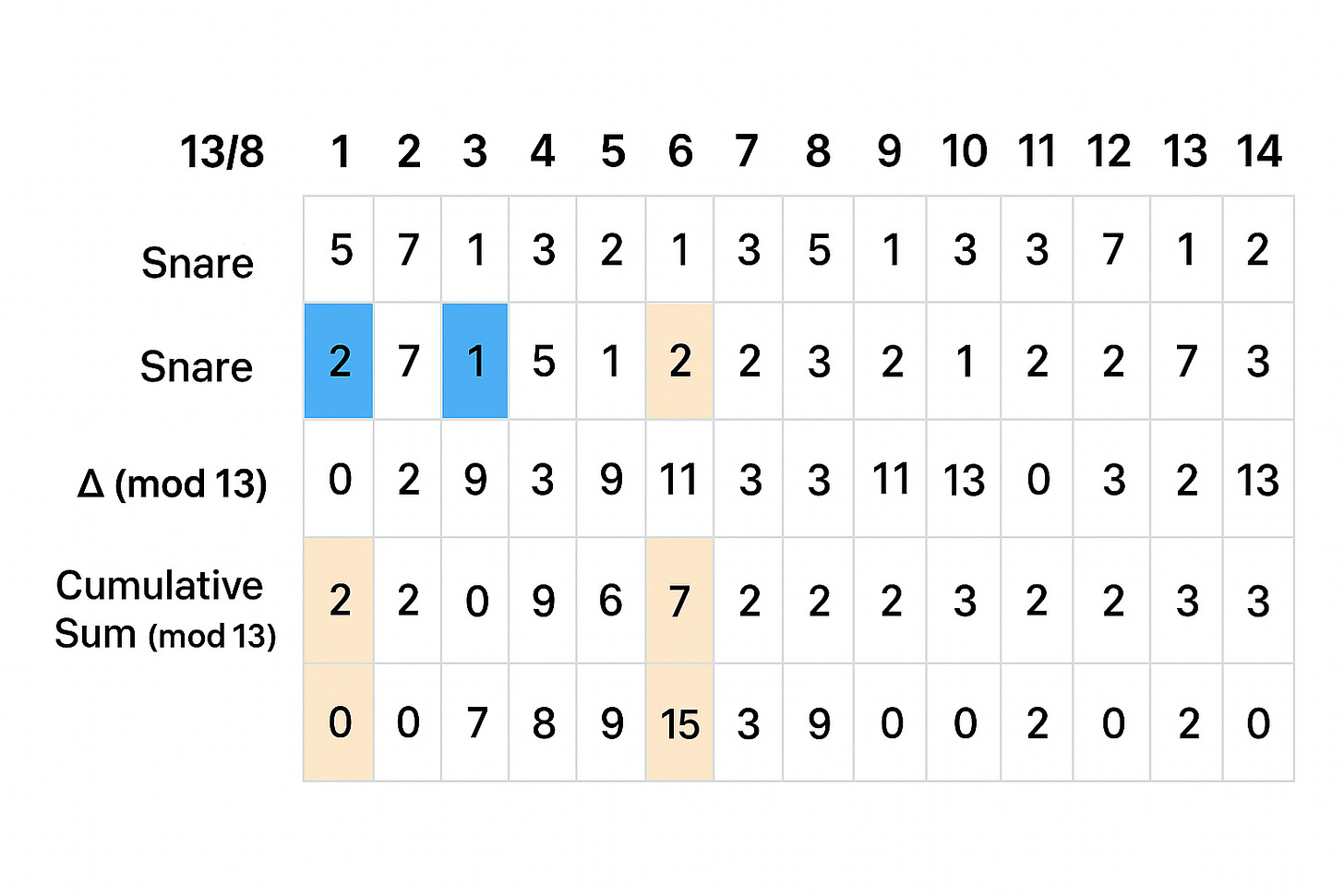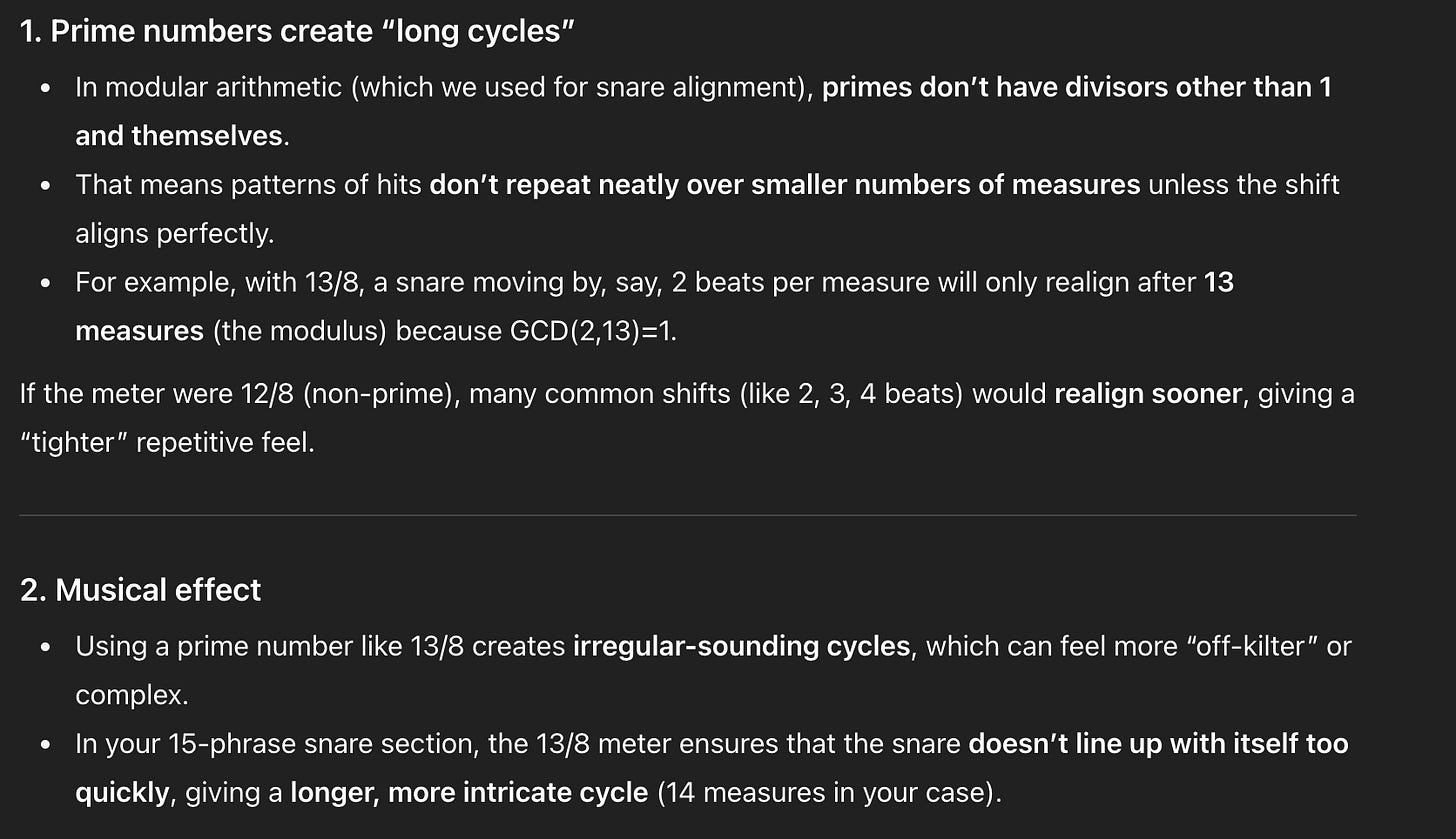“Forsake Me Not When My Strength Is Spent” Creation Notes
Part III: Music Deep Dive On The Song, "Forsake Me Not When My Strength Is Spent"
This was the third song my brother (David) and I (Daniel) worked on immediately after “Hide Me In The Shadow Of Your Wings.” While I was setting up the Pro Tools session for “Hide Me In The Shadow Of Your Wings,” my brother was noodling on the guitar unplugged and played a very simple line, which I had to record because it sounded like a song. If I remember correctly, I told my brother something to the effect of, “That’ll be the next idea we work on after this song.”
The video above shows the exact moment in time when I recorded my brother playing this line, which occurred on December 20, 2023. This song has moments that are pretty straightforward and some that are pretty complex. The entire song came about very organically, and we needed only the above riff to tab out the remainder of the song.
The next riff after the intro section is essentially the chorus riff, but without the full band playing it. This part is simple enough, but I will say that the vocals for the first verse of this song are, in my humble opinion, the best vocal takes I recorded on the entire album. I just happened to sound and enunciate near-perfectly in that small window, and I’m happy with how they came out. I remember off-handedly telling my brother to add a basic reverb filter on my vocals for the verses to give it that black metal edge/sound. I didn’t think he would remember to do it, but it wasn’t a make-or-break decision, and eventually, I forgot about it. Once I had the version of the song with vocals on it to listen to, I was surprised that it was there. My brother possesses a ridiculously good memory.
Fortunately, we found the chorus riff easy to transition to the verse riff, which is the intro riff on distortion. I like the chorus for three reasons. First, it felt unique to us. We hadn’t done a song with a distinct rhythm and lead section simultaneously before. It was nice knowing we could do it, and we enjoyed the result. Now that I think about it, this song technically had the very last part tracked for the album. Let me provide some background.
I am a nut when it comes to our music. I listened to our album in demo, instrumental, and complete stages dozens of times throughout the entire process. When we finished the album and moved on to mixing and mastering, I was driving to work one morning, listening to it, and realized my brother and I had forgotten to record something that should have been obvious. After realizing this, I immediately called him and said, “During the 2nd chorus riff with the double bass drum, you have that lead line—why didn’t we ever record a harmony line alongside that, like every 2000s-era metalcore band?” David agreed, saying he was also surprised we missed it. Before the first mixing session, my brother recorded the part in ten minutes. It was exactly what we both envisioned, and then the first mixing session began. So, although this was the third song we worked on, it also ended up being the last one we finished.
The second reason why I enjoy the chorus of this song is that my brother and I have a back-and-forth part vocally here. My brother hadn’t recorded vocals for an Every Thought Captive song since “Spellbound,” off our very first EP back in 2022, and it was cool that this song organically allowed him to do so. Both times my brother recorded vocals, it wasn’t ever forced; it was organic and straightforward, thankfully. Honestly, when we write more music in the future for Every Thought Captive, if there is an entire section where it realistically makes sense and would be cool for David to record vocals for, then it’ll happen. The last thing either of us wants is to try to force something to happen musically or lyrically when it doesn’t feel right. So, perhaps that’ll happen for a song of ours sometime in the near future.
The last reason why I enjoy the chorus for this song is perhaps the simplest reason: it’s in an odd meter, 5/4 to be exact. I remember this section originally being in 4/4, but I think both my brother and I wanted this part to have more room in it, so the musical phrase could feel more organic, and adding the extra count helped do that. Sometimes when I listen to this part of the song, the 5/4 feels so natural to me now that I almost forget this part isn’t in 4/4.
Next, the pre-chorus riff works very well for this song. My brother counts that part in a slow 4/4, but I count it in a fast 6/8. At any rate, I will say that while my part was easy to come up with and record, fitting the MIDI notes to their specific places was a nightmare. In case you didn’t already know, we use Superior Drummer 3 for our drum sounds, and I record all my parts on my Alesis electronic drum kit. At some point, we do aim to use and record a real drum kit, but we have never had the space and opportunity to do so. Hopefully, that’ll change soon! Anyways, I never write/record any full parts using MIDI while recording drums. Not that this is bad, I just enjoy the creative process too much to do that. Occasionally, I’ll write in a cymbal hit I missed or something like that, but that is as far as it goes. Personally, I don’t care if bands use MIDI for entire instruments or whatever; music isn’t a competition, and if a MIDI piano is all you have for all your instruments, more power to you. Now, when you use MIDI to write a part that you claim you can play when you actually can’t, that bugs me.
Anyways, when I record, I always quantize (have the computer place the hits for me automatically, depending on the time meter you choose) the hits after I record parts so that the drums are always perfectly on time. However, the MIDI in this one part took me hours to figure out where to place the notes. Normally, you have a MIDI grid that allows you to see the counts, so you can move the MIDI notes around and match them up perfectly to the grid or just quantize them. However, the drum part switches time signatures halfway through the pre-chorus section. I play a traditional 6/8 beat utilizing both the hi-hat and the ride cymbal, but midway through, I then play a basic 4/4 beat, and trying to match a beat in 4/4 proved very difficult to do in a 6/8 grid. I couldn’t quantize the beat either because if I did, it would have placed the hits according to a 6/8 meter, and that wasn’t the meter I was playing in, so all the hits would have been in the wrong position. Between each line in the grid, there is a bunch of empty space, and it was there during this 4/4 beat that I had to figure out exactly where in the empty space I had to place each individual hit so that everything lined up time-wise perfectly. Through a lot of trial and error, I finally figured it all out, and everything easily came together afterwards.
The bridge section of this song was, for me, a time-consuming section to write and record. My brother and I were trying to come up with ideas on what to write for the bridge, and I was like, “What if we write this part by counting eighth notes and choose an ending point according to the number of syllables the song title has? So, it would be ‘For’, ‘sake’, ‘me’, ‘not’, ‘when’, ‘my’, ‘strength’, ‘is’, ‘spent’?” Here is a video example below to see what I mean.
In the video, my left hand is hitting the syllable phrase highlighted above while my right hand is counting out the time. If you watch my right hand, I hit all my fingers on the desk 13 times, and then repeat. My brother’s guitar and bass parts are hitting the same rhythm as my left hand.
So, my brother essentially gave the go-ahead after hearing my explanation of this part, and we started writing and tabbing out this section. I probably spent a couple of days trying different beats for this part, then recording what I came up with after troubleshooting it for a while (the fills at the end of the bridge that help transition the song back into the chorus are what took the majority of time). I had to tweak the original idea for the main beat at this part because it would have required me to physically tab out the part either on my phone or on paper, and since we were on a time crunch, I opted to simplify the part instead. Here is the count below showing exactly where the snare drum hits on each count during the entire bridge section.
1st Phrase of 13/8: Snare on count 5 & 12
2nd Phrase of 13/8: Snare on count 7
3rd Phrase of 13/8: Snare on count 1 & 9
4th Phrase of 13/8: Snare on count 1 & 7
After the 3rd phrase, I had to simplify the part because if I had continued with the way it naturally felt to drum this part out, it would have felt extremely foreign to me. The technical way to state the same idea the last sentence stated is this: by reusing beat 1 and closing the spacing at beat 7, it puts a stronger accent back on the downbeat earlier in the cycle, thus making the beat easier to feel and repeat. Writing this article had me just do the math of it all now, and this is what it would have been had I decided not to change it; the first three phrases are the same, with the last one being different.
4th Phrase of 13/8: Snare on count 3 & 11
Alright, huge musical nerd time again, so this is a forewarning (Meshuggah honestly ruined me). I am going to provide a full graph of how long this whole pattern would have gone until the snare drum starts back again on count 5 and 12, like in the very 1st phrase, had I decided not to make it easier to play.
1st Phrase of 13/8: Snare on count 5 & 12
2nd Phrase of 13/8: Snare on count 7
3rd Phrase of 13/8: Snare on count 1 & 9
4th Phrase of 13/8: Snare on count 3 & 11
5th Phrase of 13/8: Snare on count 5 & 13
6th Phrase of 13/8: Snare on count 7
7th Phrase of 13/8: Snare on count 2 & 9
8th Phrase of 13/8: Snare on count 4 & 11
9th Phrase of 13/8: Snare on count 6 & 13
10th Phrase of 13/8: Snare on count 8
11th Phrase of 13/8: Snare on count 2 & 10
12th Phrase of 13/8: Snare on count 4 & 12
13th Phrase of 13/8: Snare on count 6
14th Phrase of 13/8: Snare on count 1 & 9
15th Phrase of 13/8: Snare on count 5 & 12
So, this pattern starts and fluctuates for 14 phrases until the snare drum finally comes back in on counts 5 and 12. Since I am not an uber nerd in mathematics, here is an even wilder breakdown, courtesy of ChatGPT.
Below is a chart created by ChatGPT in case, for some reason, you wanted a visual of this whole thing.
This is the kind of math that is genuinely interesting and useful to me, too bad I never learned about it in school. At any rate, learning that 13 is also a prime number is cool because prime numbers have several unique characteristics in mathematics. Here, I’ll let ChatGPT tell you all about it.
So yeah, math, pretty cool. And having AI as a conduit for your random and ridiculous music ideas to come off way more interesting and complicated than they actually are is pretty cool as well.
Anyways, the last chorus section of the song has David playing a solo-like lead that ended up working out well. Originally, I wanted an actual guitar solo here, but we eventually settled on this part being more of a lead line. The ending section of the song has David playing essentially the same part he does in the bridge, while I play hits on the toms instead of a straight beat. We were thinking of shouting the title of the song alongside the last hits that close it out, but decided against it for two reasons: it sounded way too close to the gang vocals 2000s era metalcore is known for, and it honestly sounded better just instrumentally. But yeah, that is the entire breakdown for this song. I apologize for the amount of math thrown your way, but hopefully, you got a pretty good breakdown of how this song was composed and exactly how ridiculously complex songwriting can be.







